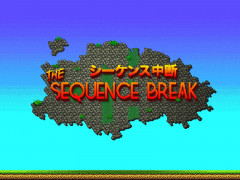
About SqncBrk
Sequence break is the act of obtaining an item out of order or performing certain action out of order. In…

I don’t know about you, but I sure love it when the game tricks me into believing that it’s something else. Knytt Underground looks like a small and cute trifle with nothing but a cool photo-collage backgrounds paired with primitive art-style and rather abstract jokes. And it ends with explosions, quite literally. Well, at least the author inserts himself into the game to tell you this in person. First two short chapters (out of three, mind you) don’t look like much. The player is introduced to the base mechanics, of which there aren't really a lot of: you can jump, climb any vertical wall, transform yourself into a big rubber ball (this particular one can be seen only in demo-level, which is included along first two chapters and has its complete separate level) and gain access to higher jumps. Occasionally you can collect a one-time-use-power-up which looks like glowing flower bud; and most of the time this “special ability” is nothing more than some fancy high jump or short free-fly-mode for getting where you couldn’t just climb up, because the wall isn’t completely even.

So I was ready to write it off with I a notion “I certainly understand why it’s so highly praised on indie scene, but…”. But then the third chapter happened. Forty minutes later, when I was realising in panic that I haven’t seen even 10% of the map and found a single save point, I realised I got into the rabbit hole; what I didn’t know is, that it would turn out to be a truly amazing adventure. The seem-to-be-obvious primary purpose of “just following the story” is being crushed by the enormous world size. You don’t really know the right path, there’s a lot of obstacles and, finally, the path to the story points is blocked by some treasure-hungry
So what did I discover here? I found a whole surrealistic underground world inhabited by sprites and fairies, who barely remember the history of this world, but call themselves strange names, like “The Internet”. They remember though the catastrophic events of war waged by humans, that ended with the world being reduced to these scattered survivors, living in ruins, holding mystic beliefs and treating leftover household items from pre-war times as magical powerful artefacts. And yet these folks have enough in them to give you a good reason for watching them in natural habitat, exploring their lives and getting from them pieces of history. It will never, though, become clear what really happened. You didn’t really expect that from a game, which literally is dedicated to uncertainty and meaning of seeming obscure final goal? Yep, that’s it, fourth wall is a regular punchbag here.

Aside from the cryptic story and chilling ambience of the scenery, there’s more too. The gameplay makes a sudden skyrocketing, shifting from “mindless jumping” to “carefully solving puzzles with jumps”; and not only with jumps. Rubber ball form now becomes useful not only for jumping higher, but for doing all kinds of tricks. Those simple power-ups now require planning before their usage. One wrong move — and at best you’ll have to try again, sometimes dying from contact with molten lava or not-so-friendly-robot laser beam. And that’s not worst that could happen, sometime you’ll fail so bad, you’ll fall to the other screen; getting back up isn’t an easy task for most of the time. But with enough focus and thinking you’ll get all those coins, and flowers, and keyboard keys, and maybe even some secret symbols. Even if you don’t it won’t change much; a game that is filled with secrets won’t hide that much if you won’t find all of them. After all, that was the message of it. If the goal isn’t clear, or doesn’t really make sense, it will be the false one.